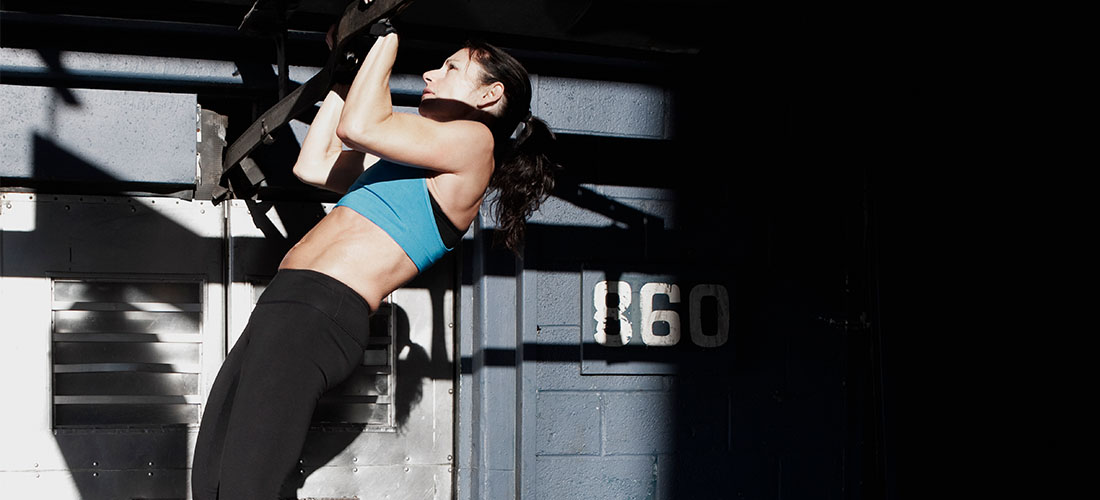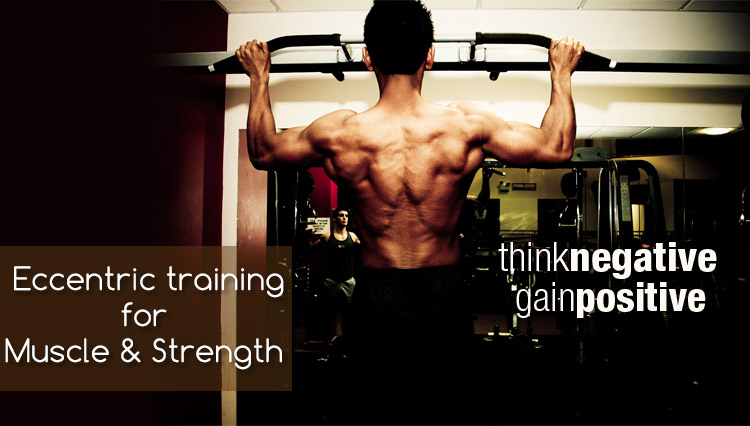30 push-ups. 25 push-ups. 20. 15. 10….
You have burnt your muscles out. You have tried as far as your mind and body will let you go. You have worked hard to stick to your routine. But you are still not seeing results as fast as you would like.
It’s time to try something different.
Contents
What is Eccentric Training?
You have probably heard about it. But never really paid attention – mostly because you presume it is something that will require more time and effort, and you would rather stick to what you are doing.
Believe it or not, if you have been doing any form of weight training, you have been doing at least some eccentric training. You just didn’t know it yet!
When you are doing any sort of weight bearing exercise, two types of muscle contractions are involved – concentric and eccentric. To understand eccentric contractions, we must know a little about concentric first.
Concentric or positive contractions shorten your muscles, for example, when your biceps shorten as you lift a dumbbell or your chest muscles tighten when you go up in a push-up.
Eccentric contractions, you guessed it, are just the opposite. Your contracting muscles are forcibly lengthened[1] – such as when your biceps are slowly bringing the dumbbell back down or when your chest muscles slowly elongate as you go down in the push-up.
In simple words, eccentric contractions slow your movements when gravity is pulling you down. It is not surprising, then, that they are also called Negative Contractions.
Downhill walking is another very common example you should be able to relate to. When you are going down a slope, your quads control your descent by preventing knee flexion from occurring too fast. This helps you to control your downhill speed.
Now that you have a basic idea of what an eccentric contraction is, let’s see how it helps you to build muscle mass and strength.
Eccentric Hurts – In a Good Way
Assuming that you are really focusing on eccentric contractions for the first time, your muscles are going to be sore and stiff like crazy the next day – even if you perform the same number of reps as you have been doing all along. This is because for a given workload eccentric training causes more microscopic damage to the muscle and induces more muscle regeneration than concentric training.[2]
This soreness will gradually go away as your body adapts but that doesn’t mean you will stop benefitting from negative contractions. It has been repeated time and again that muscle soreness is not a reliable indicator of increase in muscle mass.[3]
You may not feel sore after continuing with the same workout for several days but muscle growth may still be happening as long as you are giving your best. If you don’t trust me, take a selfie or wrap a measuring tape around your arm or your chest – do this every week and compare the results.
Eccentric Better than Concentric
It is worth repeating that eccentric kicks concentric’s ass. Research has shown that the ability of eccentric training to develop higher loads on the muscle than concentric contractions makes it better at increasing muscle mass and strength.[4]
You might be thinking – do eccentric contractions only improve my eccentric ability? Will they only allow me to hang on to the edge of a mountain? Will they not help me develop enough strength to pull myself up? Well people, the answer is YES they will!
A study has shown that eccentric training increased concentric strength by bringing about changes in muscle fibers and their cross-sectional area. What’s more, this effect was even seen in people who had been training in the gym for ages. However, if we look at the other side of the coin, concentric training had only minor improvement in eccentric contractions.[5]
In essence, focus on eccentric training improves your overall strength, not just eccentric contractions.
As if all this was not enough, a combination of concentric and eccentric training has been shown to increase bone mineral density and bone content in young women – even your bones become stronger as they are repeatedly subjected to positive and negative stress.[6]
Common Eccentric Movements
It is very easy to incorporate eccentric contractions in your routine. The idea is to try and release the weight as slowly as possible once you have performed the contraction phase. A good method is to count from 1 to 5 or 1 to 10 as you go down.
Here are a few examples of eccentric movements in some common weight training exercises:
- Bicep curls – Bring the weights down as slow as possible.
- Triceps dips – Bring your body down slow after lifting it up against a chair or stool.
- Push-ups – Go down from the plank position and touch the ground with your chest in a slow and controlled manner.
- Pull-ups or Chin-ups – Release the tension in your back and arms slowly as you go back to the starting position.
- Squats – The eccentric part of a squat is when you are going down into the squat position.
I believe that from the above examples, it should be pretty clear to you that the eccentric phase helps you to slow down as the weight of the dumbbells or your body tries to rapidly descend.
As with every exercise, your body will gradually adapt to your eccentric training. If you want to continue increasing muscle mass, you can either increase the load or go even slower. Say, you were counting to 5, now, you can go up to 6 or 7 or higher.
When should I do Eccentric Training
There are basically two ways to incorporate eccentric movements into your workout. Though, there is no conclusive research as to which one works best, you may want to try both and see what works best for you.
First method is to do them from the start of your workout. You finish a positive contraction and you follow it up with a negative contraction.
Secondly, some fitness experts recommend eccentric movements to be performed only after completing your regular set. When you are fatigued after a set of concentric contractions, do as many eccentric contractions as possible. This will completely burn your muscles out and may give you better results.
You could even mix and match. Variety keeps your muscles from plateauing too fast.
Be Safe
As with every exercise, try and pace yourselves.
Do not focus only on the eccentrics for your first few workouts. Gradually work them in and increase the number of repetitions.
Have fun working out. See you next time!
Other related articles:
1. Are Deep Squats Bad For Your Knees?
2. Occlusion Training – Lift Lighter, Get Bigger
3. Plateau Busting Workout Tips From Celebrities
References [1]Proske U, Morgan DL. Muscle damage from eccentric exercise: mechanism, mechanical signs, adaptation and clinical applications. J Physiol. 2001 Dec 1;537(Pt 2):333-45. Review. PubMed PMID: 11731568; PubMed Central PMCID: PMC2278966. ^Back to Top^ [2] Zeviani, M. (2008). Train, train, train! No pain, just gain Brain, 131 (11), 2809-2811 DOI: 10.1093/brain/awn264^Back to Top^ [3] Clarkson, Priscilla M., Kazunori Nosaka, and Barry Braun. "Muscle function after exercise-induced muscle damage and rapid adaptation." Medicine and science in sports and exercise 24.5 (1992): 512-520.(pdf) ^Back to Top^ [4] Roig M, O'Brien K, Kirk G, Murray R, McKinnon P, Shadgan B, Reid WD. The effects of eccentric versus concentric resistance training on muscle strength and mass in healthy adults: a systematic review with meta-analysis. Br J Sports Med. 2009 Aug;43(8):556-68. doi: 10.1136/bjsm.2008.051417. Epub 2008 Nov 3. Review. PubMed PMID: 18981046. ^Back to Top^ [5] Vikne H, Refsnes PE, Ekmark M, Medbø JI, Gundersen V, Gundersen K. Muscular performance after concentric and eccentric exercise in trained men. Med Sci Sports Exerc. 2006 Oct;38(10):1770-81. PubMed PMID: 17019299. ^Back to Top^ [6] Nickols-Richardson SM, Miller LE, Wootten DF, Ramp WK, Herbert WG. Concentric and eccentric isokinetic resistance training similarly increases muscular strength, fat-free soft tissue mass, and specific bone mineral measurements in young women. Osteoporos Int. 2007 Jun;18(6):789-96. Epub 2007 Jan 31. PubMed PMID: 17264975. ^Back to Top^
– Dr. Praful Schroff






Comments are off this post!